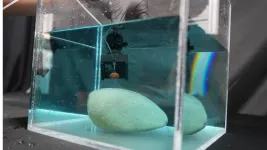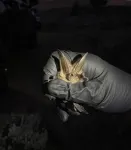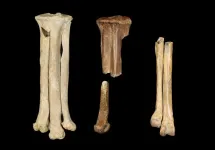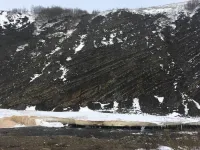(Press-News.org) According to highly cited conventional models, cooling and a major drop in sea levels about 34 million years ago should have led to widespread continental erosion and deposited gargantuan amounts of sandy material onto the ocean floor. This was, after all, one of the most drastic climate transitions on Earth since the demise of the dinosaurs.
Yet a new Stanford review of hundreds of studies going back decades contrastingly reports that across the margins of all seven continents, little to no sediment has ever been found dating back to this transition. The discovery of this globally extensive gap in the geologic record was published this week in Earth-Science Reviews.
“The results have left us wondering, ‘where did all the sediment go?’” said study senior author Stephan Graham, the Welton Joseph and Maud L’Anphere Crook Professor in the Stanford Doerr School of Sustainability. “Answering that question will help us get a better fundamental understanding about the functioning of sedimentary systems and how climatic changes imprint on the deep marine sedimentary record.”
The geological gap offers fresh insights into sediment deposition and erosion processes, as well as the broader environmental signals from dramatic climate change, which could help researchers better grasp the global enormity of today’s changing climate.
“For the first time, we’ve taken a global look at an understudied response of the planet’s largest sediment mass-movement systems during the extreme transition of the Eocene-Oligocene,” said study lead author Zack Burton, PhD ’20, who is now an assistant professor of Earth sciences at Montana State University.
Tim McHargue, an adjunct professor of Earth and planetary sciences at Stanford, is also a co-author on the study.
From hothouse to icehouse
During the Eocene-Oligocene period, Earth underwent profound planetary cooling. Giant ice sheets appeared in Antarctica, which was previously ice-free, global sea level plunged, and land and marine life suffered severe die-offs.
Prior to that, in the early part of the Eocene that lasted from about 56 million to 34 million years ago, Earth had the warmest temperatures and highest sea levels since dinosaurs walked the Earth more than 66 million years ago, according to climate-proxy records.
Burton and colleagues initially focused on exploring the effects of early Eocene conditions on deep-sea depositional systems. The resulting study – published in Nature Scientific Reports in 2023 – found abundant sand-rich deposits in the ocean basins along Earth's continental margins. The research team attributed this deposition increase mainly to intensified climatic and weather conditions boosting erosion from land. Their curiosity piqued, Burton and colleagues then extended the investigation to the late Eocene and early Oligocene, when Earth suddenly went from “hothouse” and “greenhouse” climates to the opposite, an “icehouse” climate.
For the new study, the researchers painstakingly pored over scientific and technical literature documenting ancient sediment up to several kilometers beneath the sea floor, surveying studies published in the past decade to over a century ago. The literature included offshore oil and gas drilling studies, onshore rock outcrop studies, and even interpretations of seismic data to infer Eocene-Oligocene sediment characteristics. In total, just over a hundred geographical sites worldwide were included, outlining every continental landmass.
While the study’s method of literature analysis is not new on its own, the scale of such an approach made possible by vast online databases could prove highly illuminating, Graham said. “There could be other similar events in the geologic past that would bear a closer investigation,” said Graham, “and the way to start that is by doing exactly what we did – a really thorough canvassing of the global geologic literature for certain suspect periods in time.”
“The actual process of reappraising, reinvestigating, and reanalyzing literature that has in some cases been out for decades is challenging, but can be very fruitful,” Burton said. “The method can lead to exciting and unexpected findings, like we were able to make here.”
Wholly unanticipated
As Burton and his colleagues made their way through the compiled data inventory, they grew increasingly perplexed by the apparent sedimentary no-show.
“We didn’t see abundant sand-rich deposition, as in our study of warm climates of the early Eocene,” said Burton. “Instead, we saw that prominent, widespread erosional unconformities – in other words, gaps in the rock record – had developed during the extreme climatic cooling and oceanographic change of the Eocene-Oligocene.”
The researchers offer a few theories about why this lack of deposition occurred. Vigorous ocean bottom currents, driven by temperature and salinity of the waters, may have been triggered or magnified by the major climate shift, potentially eroding the ocean floor and sweeping away sediment that flowed off the continents. Meanwhile, mechanisms from continental shelves exposed by sea-level fall could have allowed sediments to entirely bypass the closer-in sedimentary basins, sending deposits much farther out onto the abyssal plain of the ocean floor. More regionally restricted processes, like glacial erosion around Antarctica, likely played a part, too.
Whatever mechanisms may have been in play, they collectively created similar scenes of erosion in oceanic basins around every continent. That ubiquity points to what the researchers referred to as global controls – meaning that profound climatic change was felt everywhere, from the tallest landmasses down into the deepest waters.
In this way, the abrupt climatic event at the Eocene-Oligocene boundary and its newly observed, substantial effects along continental margins could help researchers better grasp the global enormity of today’s unfolding climate change. Although the human-caused climate change of the past couple centuries is currently much smaller in overall magnitude compared to the Eocene-Oligocene transition, it is happening at an alarmingly faster pace, the Stanford researchers said.
“Our findings can help inform us of the kinds of radical changes that can happen on the Earth’s surface in the face of rapid climate change,” said Graham. “The geologic past informs the present, and particularly the future.”
The research was supported by the Stanford Project on Deepwater Depositional Systems and Basin Processes and Subsurface Modeling industrial affiliates programs. Stanford industrial affiliates programs are funded by membership fees from companies. View current Stanford Doerr School of Sustainability affiliates members.
END
Ancient climate analysis reveals unknown global processes
2024-10-09
ELSE PRESS RELEASES FROM THIS DATE:
Gene therapy shows long-term benefit for patients with a rare pediatric brain disease
2024-10-09
Cerebral adrenoleukodystrophy (CALD) is a rare progressive, genetic brain disease that primarily presents in young boys, causing loss of neurological function and ultimately leading to early death. Researchers from Massachusetts General Hospital, a founding member of the Mass General Brigham healthcare system, Boston Children’s Hospital, and collaborators have shown that six years after treatment with the first gene therapy approved for CALD, 94 percent of patients have had no decline in neurological functioning, with over 80 percent remaining free of major disability. Findings, published in two articles in the New England Journal of Medicine, describe long-term outcomes ...
Do people with MS have an increased risk of cancer?
2024-10-09
MINNEAPOLIS – A new study has found some cancers to be slightly more frequent in people with multiple sclerosis (MS) than in people without MS. The study is published in the October 9, 2024, online issue of Neurology®, the medical journal of the American Academy of Neurology. Types of cancers found to have a small increased risk include bladder, brain and cervical cancers. The study does not prove that MS increases a person’s risk of cancer. It only shows an association.
With MS, the body’s immune system attacks myelin, the fatty, white substance that insulates and protects the nerves. MS is chronic and can be unpredictable and disabling.
“People ...
New research on octopus-inspired technology successfully maneuvers underwater objects
2024-10-09
Using mechanisms inspired by nature to create new technological innovations is a signature of one Virginia Tech research team. The group led by Associate Professor Michael Bartlett has created an octopus-inspired adhesive, inspired by the shape of octopus suckers, that can quickly grab and controllably release challenging underwater objects.
Having the ability to grab and release these underwater objects like heavy rocks, small shells, and soft beads, and other debris could be a powerful tool for underwater salvage and even rescue operations. Their findings have been published in Advanced Science.
This work was performed with undergraduate researchers Austin Via, Aldo Heredia, ...
Newly discovered Late Cretaceous birds may have carried heavy prey like extant raptors
2024-10-09
Newly discovered ancient birds from Late Cretaceous North America were hawk-sized and had powerful raptor-like feet, according to a study published October 9, 2024 in the open-access journal PLOS ONE by Alexander Clark of the University of Chicago, U.S. and colleagues.
The most diverse birds during the Cretaceous Period were a now-extinct group called enantiornithines, known from all over the world during this time. However, enantiornithines and other Mesozoic birds are mainly known from Lower Cretaceous deposits, with a relatively poor record ...
Bat species richness in San Diego, C.A. decreases as artificial lights, urbanization, and unconserved land increase, with Townsend's big-eared bat especially affected
2024-10-09
Bat species richness in San Diego, C.A. decreases as artificial lights, urbanization, and unconserved land increase, with Townsend's big-eared bat especially affected
###
Article URL: https://journals.plos.org/plosone/article?id=10.1371/journal.pone.0310812
Article Title: Quantification of threats to bats at localized spatial scales for conservation and management
Author Countries: U.S.A.
Funding: The United States Geological Survey Western Ecological Research Center and Ecosystems Mission Area provided funding and support, and the National ...
Satellite data shows massive bombs dropped in dangerous proximity to Gaza Strip hospitals in 2023
2024-10-09
Satellite data on the proximity of hundreds of M-84 bomb craters to hospitals in the Gaza Strip suggests that, as of November 2023, hospitals were not being given special protection from indiscriminate bombing, as mandated by international humanitarian law. That is one finding out of a new study published this week in PLOS Global Public Health by Dennis Kunichoff of Harvard University, and colleagues.
On October 7, 2023, Israel launched a major military campaign in the Gaza Strip in response to Hamas militant attacks in Israel. Among the munitions being used are United-States-provided Mark-84 (M-84) bombs, which are air-dropped explosive munitions that shoot more than 1000 pounds ...
Predatory birds from the same fossil formation as SUE the T. rex
2024-10-09
The Hell Creek Formation in what’s now the Dakotas, Montana, and Wyoming was once home to some of the world’s most beloved dinosaurs, like Triceratops and Tyrannosaurus rex (including SUE, one of the largest, most complete, and best-preserved T. rex specimens ever found). But these giant dinosaurs weren’t alone in their ecosystem, and in a paper in the journal PLOS ONE, scientists have described two new species of birds that lived alongside these dinosaurs 68 million years ago. The researchers ...
Sexist textbooks? Review of over 1200 English-language textbooks from 34 countries reveals persistent pattern of stereotypical gender roles and under-representation of female characters across countri
2024-10-09
Gender biases around male and female roles and under-representation of female characters appeared in textbooks from around the world, with male-coded words appearing twice as often as female-coded words on average, according to a study published October 9, 2024 in the open-access journal PLOS ONE by Lee Crawfurd from the Center for Global Development, United Kingdom, and colleagues.
School textbooks play an important role in shaping norms and attitudes in students—one reason why controversy ...
Interview with Lee Crawfurd, Center for Global Development, United Kingdom
2024-10-09
Interview with Lee Crawfurd
###
What first drew you to study gender bias in school textbooks, and why did you choose to investigate this topic?
I was raised by a gay feminist single mother who was a school teacher and loves to challenge gender stereotypes, so this is something I've always been interested in. This personal background, combined with recent advancements in computerized text analysis and the new availability of digital textbooks, led me to this line of research.
What are the key findings from your research?
It's not really news that there is some ...
Scientists show accelerating CO2 release from rocks in Arctic Canada with global warming
2024-10-09
Researchers from the Department of Earth Sciences at the University of Oxford have shown that weathering of rocks in the Canadian Arctic will accelerate with rising temperatures, triggering a positive feedback loop that will release more and more CO2 to the atmosphere. The findings have been published today in the journal Science Advances.
For sensitive regions like the Arctic, where surface air temperatures are warming nearly four times faster than the global average, it is particularly crucial to understand the potential contribution of atmospheric CO2 from weathering. ...







